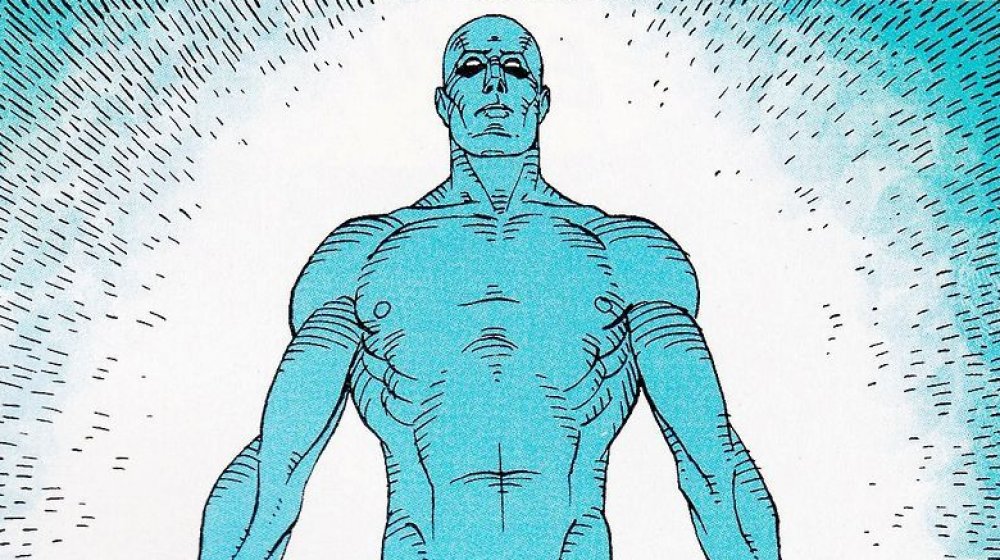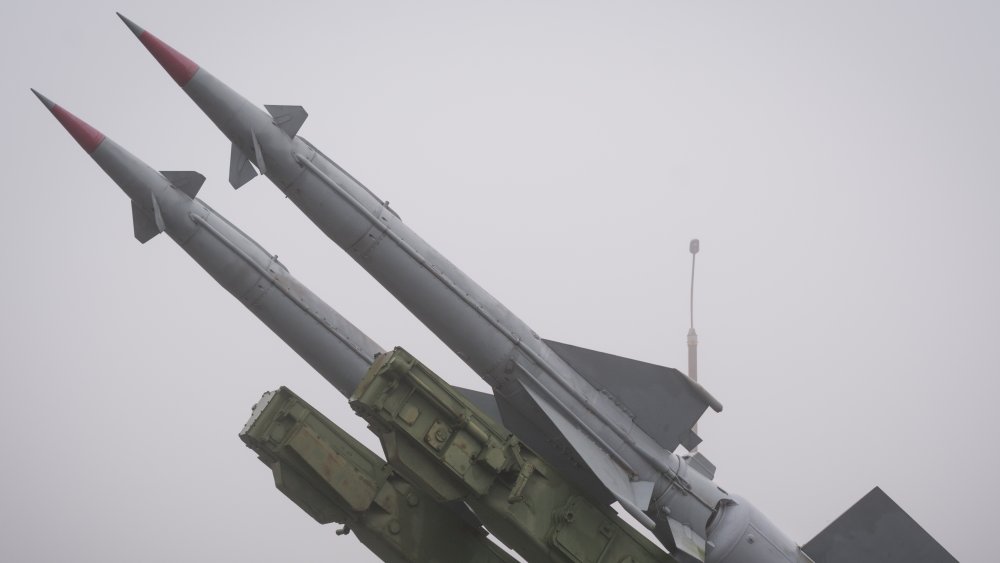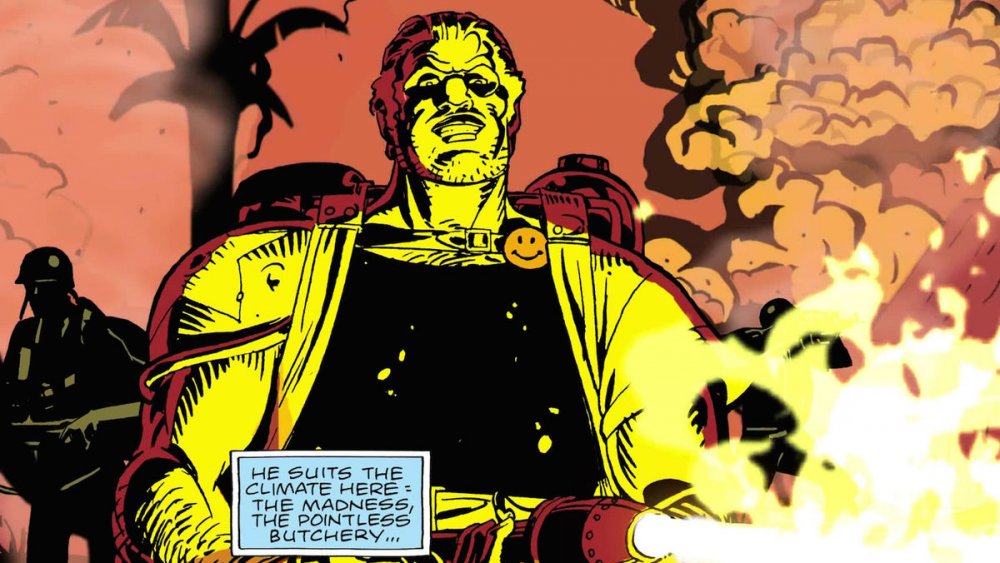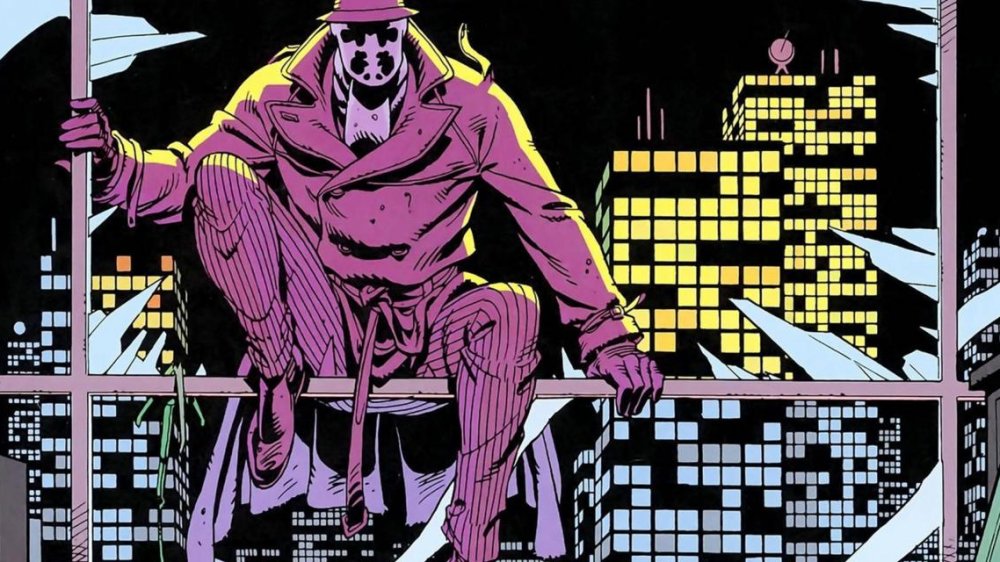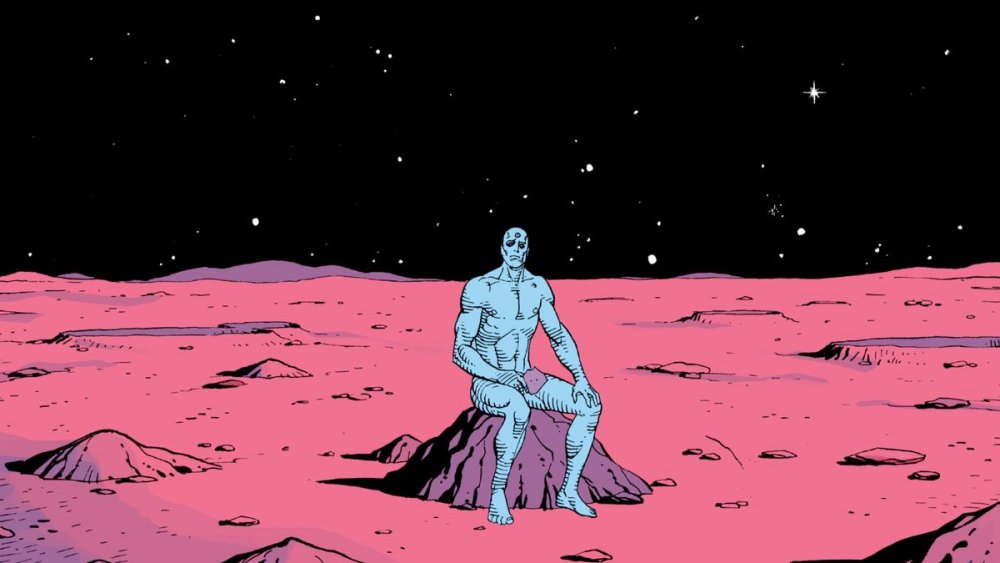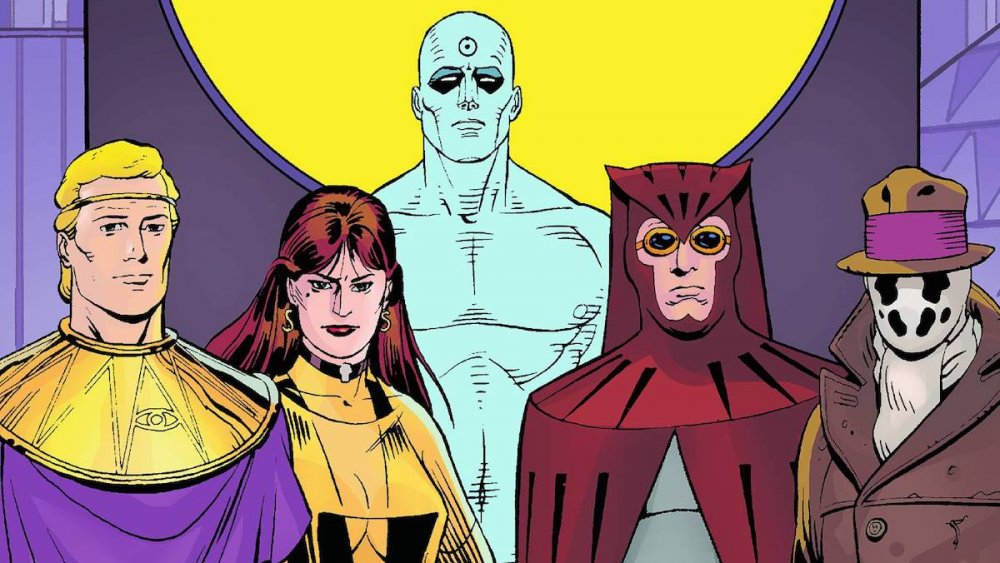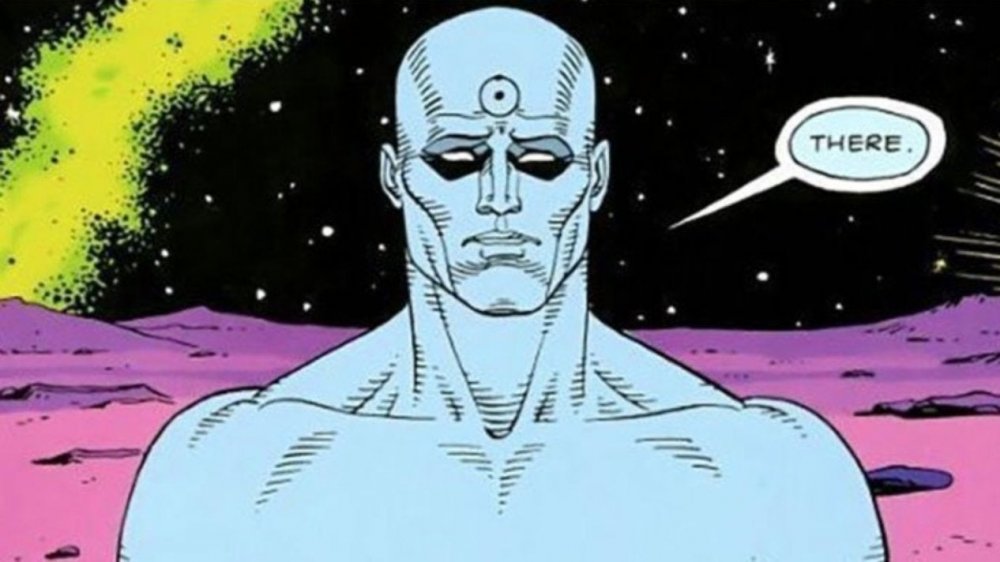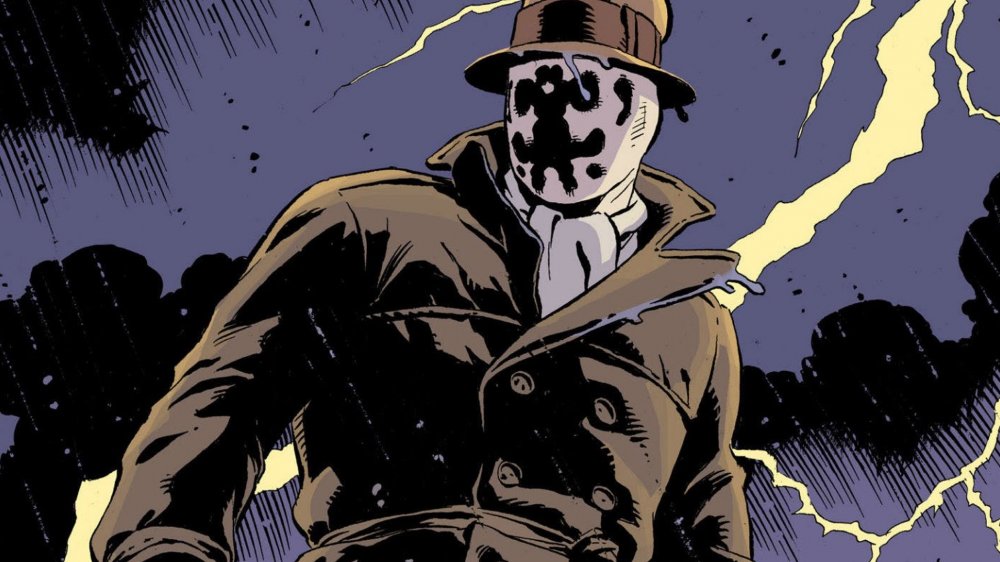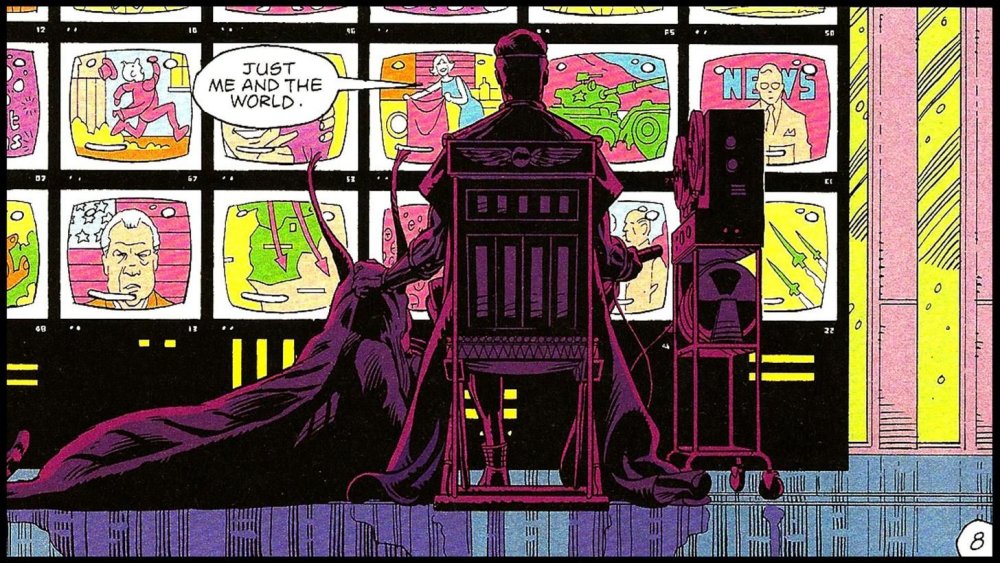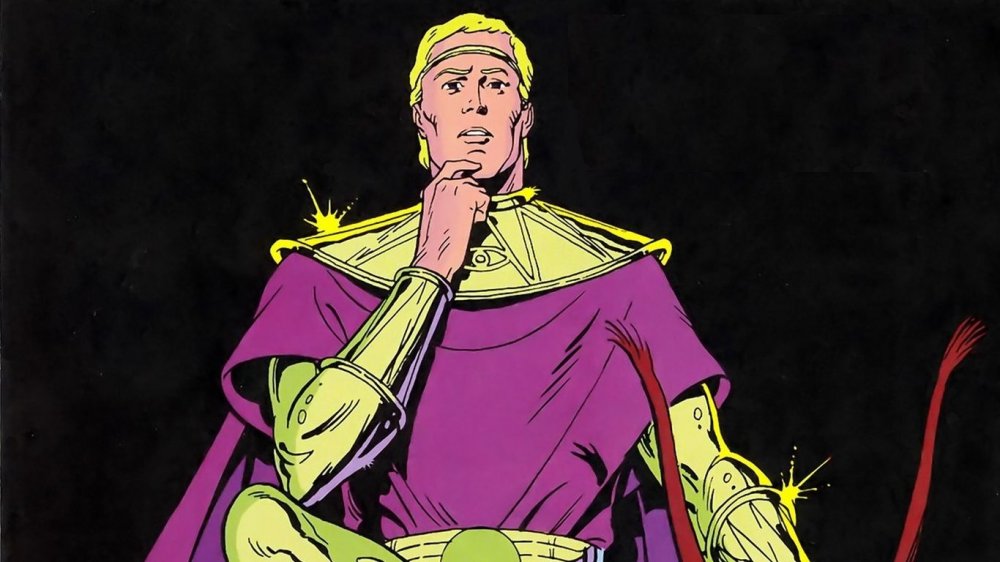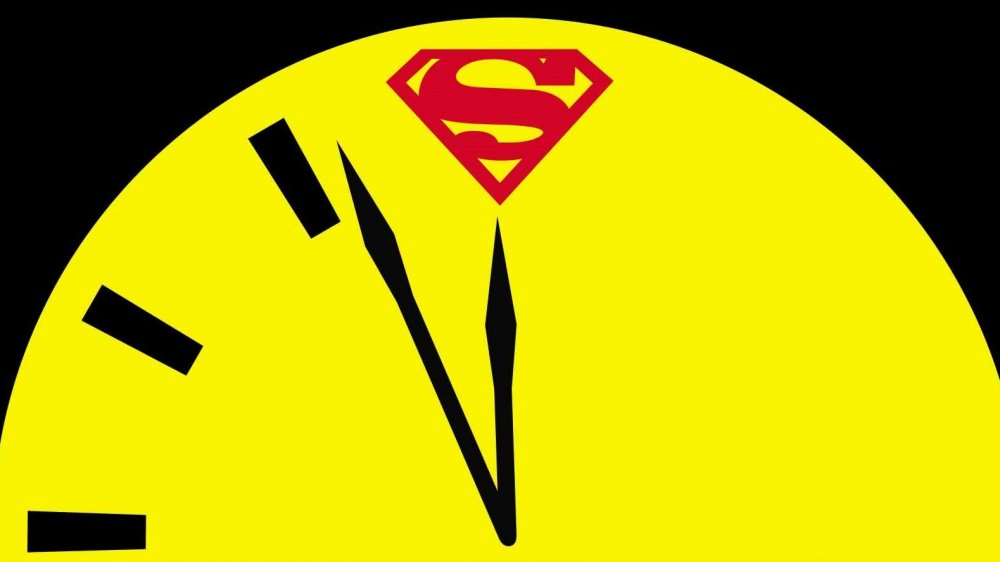The Entire Story Of Watchmen In The Comics Explained
Alan Moore and Dave Gibbons' Watchmen changed comic books forever. A superheroic magnum opus, it turns typical takes on the Cold War inside out, thoroughly eviscerating the idea of super-powered Boy Scouts in the process. By taking a look at a crew of former superheroes washed up on the grim shores of the 1980s, Watchmen examines the world's rightward creep toward authoritarianism, the place of force in civil society, and the propagandistic use of ultra-patriotic comic book heroes. Gung-ho spandex-wearers, Watchmen concludes, would have all the problems of their real-world counterparts — only at a much larger scale.
Complex stuff to be sure. But a firm grasp on the storyline makes Watchmen's cultural commentary quite a bit easier to comprehend and all the more resonant. With that in mind, we've detangled Watchmen's occasionally knotty timeline to help further understanding of one of the best books (with or without pictures) ever written. Enjoy, and remember: the doomsday clock is ticking.
Duck and cover
Before you can understand the story of Watchmen, you have to understand the world it takes place in. That world would be recognizable to anyone reading it as it was released — it was, after all, merely a heightened version of Cold War reality.
In Watchmen, the Soviet Union and the United States are engaged in a seemingly endless game of nuclear brinkmanship. The irradiated apocalypse looms large over every page, driven home home by the iconic doomsday clock, ticking down the likely seconds until mankind kills itself. The parallels between our world and Watchmen's are obvious — the 1980s were, after all, conducted in the shadow of nuclear war. But many seemingly fantastical elements of Watchmen are entirely real. The doomsday clock, for example, is a symbol created by The Bulletin of the Atomic Scientists in 1947 to warn of potential nuclear annihilation, deep in the era of comics Watchmen is skewering. As the graphic novel zips along, Moore and Gibbons build tensions by shifting the minute hand closer to midnight. Our world doesn't have Doctor Manhattan traipsing around it, but the clock — and the anxiety it symbolizes — are all too real.
Superheroes, courtesy of the US government
Watchmen's characters are deliberate caricatures of Golden Age superhero archetypes. Nite Owl is he gadget-loving detective who zips around in vehicles beamed from an Atomic Age future. Rorschach is the grim private dick who prowls the seedy underground and speaks in clipped phrases. Doctor Manhattan is the impossibly powerful superhuman who can bend reality to his will. Silk Spectre is the legacy hero, her mother having been the first Silk Spectre in the 1940s. The Comedian is the steadfast soldier, ready with a quip and a smile. All of them have been put out of commission by anti-vigilantism bills, with the exception of Doctor Manhattan and The Comedian, who work for the US government.
Manhattan is a former scientist who was turned into an omnipotent being after a nuclear experiment gone wrong. He functions as a super weapon for the US and a propaganda tool that casts the country's ongoing conquests as morally right. His presence makes the Soviet Union eye the nuclear option ever more eagerly, as Manhattan's abilities are, frankly, godlike: He was able to single-handedly win the Vietnam War for the US.
The Comedian represents the less overt side of American imperialism, working as a mercenary in coups in leftist states around the world. The cigar-chomping Joe is made monstrous by Moore and Gibbons, and it's his shocking death that sets the story in motion.
The death of Edward Blake
The story opens in 1985 with Edward Blake, better known as The Comedian, falling to his death from his New York City high-rise. The massive and burly Blake is surprised in his apartment by an unseen assailant and tossed through a plate-glass window. Both the police and Blake's former superheroic colleagues are stumped as to how anyone could have gotten the drop on the lifelong soldier.
Though masked vigilantism was outlawed amidst public outcry in 1977, the team's grim and mentally unstable detective Rorschach has continued to investigate crimes as a brutal sort of superhero. Known for his unsettling inkblot mask and resolutely cynical narration, Rorschach is one of the book's most striking characters. He looks into Edward Blake's death and determines that he was The Comedian, a masked hero who had fought crime in two separate superhero groups: the mid-century Minutemen and a later group called the Crimebusters, of which Rorschach was a member. Members of the Crimebusters attend Blake's funeral and Rorschach puts in the leg work to track down his former colleagues, as he believes a plot to kill former masked crime-fighters is in the works.
Doctor Manhattan in exile
Having spent years using his prodigious powers on behalf of the US government, Doctor Manhattan is shocked when he is accused of giving his former associates cancer. The accusation hurts Manhattan deeply and uncharacteristically: Though his abilities to see all of space and time and bend matter to his will have left him detached from humanity in many ways, they have also brought him closer to their triumphs and tragedies. Reeling, Manhattan reacts poorly and transports himself to Mars. On that remote planet, he contemplates his place in the universe — and keeps his distance from the humans he might be poisoning with his very presence.
Doctor Manhattan's escape from Earth causes immediate chaos. The living super weapon is in the employ of the US government, and his disappearance shifts the balance of the ongoing Cold War significantly. The Soviet Union takes advantage of America's drastically weakened ability to respond by invading Afghanistan. But that's not the only trouble happening down on Earth: Manhattan's lover Laurie Juspeczyk, the second Silk Spectre who fought alongside him in the Crimebusters, is drifting away from him. Torn apart by traumas of her own, she is unable to cope with his inhuman elevation above earthly matters, and inches closer to a relationship with Daniel Dreiberg, the former Nite Owl.
Back on Earth
The idea that someone might be targeting former superheroes gets a strong boost when an attempted assassination of Adrian Veidt fails. Veidt, world-famous for his intellect and wealth, formerly fought the forces of evil as a member of the Crimebusters, under the name Ozymandias. Following the abolition of vigilantes, Veidt used his significant resources to expand into everything from toy manufacturing to cosmetics, become one of the most powerful billionaires on Earth. He is widely regarded as the "smartest man alive" and the assassination attempt comes as a shock, given the endless goodwill he's offered by the media.
In the meantime, Rorschach is framed for the murder of a former supervillain named Moloch. His true identity is revealed upon his arrest: He is a man named Walter Kovacs. Having once been a foster kid whose early promise crumbled beneath the weight of trauma and alienation, he is forced into counseling sessions that do little aside from scarring his prison-appointed psychologist.
Elsewhere, Juspeczyk and Dreiberg begin to fight crime under their old mantles of Silk Spectre and Nite Owl. Unlike Rorschach, who is driven by a hatred of criminals he sees as scum, the pair begins fighting again to exert control over some small portion of their own lives. Soon, they begin to see that there is truth to the theory that former vigilantes are being targeted for death. They break Rorschach out of prison and begin investigating the idea that a conspiracy against superheroes is afoot.
A case for humanity
Doctor Manhattan's time on Mars nearly convinces him to abandon humanity entirely. However, he calls on his long-time partner Juspeczyk to advocate for the human race before he finalizes his decision.
Laurie argues that Doctor Manhattan's elevated perch above humanity is robbing him of the granular details of human life. She tells Manhattan that people are incredibly complicated, pushing back against the aloof attitude Manhattan now maintains towards the human race. To make her point, Laurie grapples with a painful part of her past that reveals humanity's ability to surprise: Laurie is the daughter of the original Silk Spectre and The Comedian, born of a consensual liaison, despite the fact that The Comedian had assaulted Silk Spectre years prior. The sheer unlikelihood of Laurie's existence shocks Manhattan out of his comfortable condescension — humans are, he realizes, bewildering miracles, their brief lives the culmination of countless choices, accidents, and happenstance. While he could never again be human, Manhattan admits that people are worthy of study and decides to return to Earth.
Following leads
Rorschach and Nite Owl immerse themselves in the grimy underbelly of New York City. Roughing up the usual suspects leads them down a path that, to their surprise, points squarely at their former teammate, Ozymandias. Though the attempt on Ozymandias' life had been the push Nite Owl and Silk Spectre needed to believe Rorschach's claims of a conspiracy, it was beginning to appear more and more likely that Ozymandias himself was behind the sinister string of murders.
Fearing that he might not live through a confrontation with Ozymandias, Rorschach mails his journal, stuffed with his case notes and suspicions, to a right-wing magazine called the New Frontiersman. He and Nite Owl fly to Ozymandias' Antarctric stronghold, a sprawling, luxurious base called Karnak. They have no idea what, exactly, they will find in the billionaire's very own Fortress of Solitude. They are hundreds of miles away from any outside help. No one with any real power knows what they are intending to do. But they have no choice, and so they venture into the snowy wasteland to confront the man very possibly planning their own murders.
A plot uncovered
Rorschach and Nite Owl confront Ozymandias inside his icy fortress — but as the comic reveals, Ozymandias had been watching their approach for hours. Confident in his preparations, he admits to the shocked pair that they are completely correct: He is responsible for setting nearly every event of the story in motion through a plot that was years in the making.
Firstly, Ozymandias secretly poisoned people close to Doctor Manhattan so that the world would believe the superhero was toxic. Manhattan is, after all, an unprecedented power, and Ozymandias knew it was necessary to remove him from Earth if he hoped to pull off his grand scheme. Then the former superhero had The Comedian killed, framed Rorschach for the murder of Moloch, and staged his own assassination attempt to avoid suspicion.
All of this was in service of his ultimate plan: To destroy a significant portion of New York City in a fake alien attack. Ozymandias had developed a genetically engineered squid monster that would kill millions in a massive blast. He hoped to end the human drive towards nuclear war by providing the Earth with a common enemy: alien outsiders.
Rorschach and Nite Owl find his casual talk of mass murder for a highly theoretical "greater good" abhorrent. They attack Ozymandias and vow to stop him, at which point Ozymandias reveals they are too late. The "alien invasion" is already underway and New York City is seconds away from turning into a smoking ruin.
A plan already in motion
Rorschach and Nite Owl are forced to watch on Ozymandias massive wall of televisions as millions of people die instantly.
At the same time, freshly convinced of humanity's worth, Doctor Manhattan teleports into New York City with Laurie. They arrive in the immediate aftermath of the falsified alien attack and attempt to make sense of the destruction that surrounds them. Doctor Manhattan scans the Earth and detects unusual activity above Ozymandias' Antarctic base. He takes Laurie to the base and Ozymandias again explains his actions.
Before the pair can attack him, Ozymandias is seemingly vindicated by the news reports that fill his wall of televisions. In the wake of the attack, global superpowers have agreed to work together while they recover from the interstellar assault. All but Rorschach agree that the truth of the attack can never get out, as it would end the fragile and hard-won peace between nations.
Rorschach attempts to leave the base and expose the plan, only to be atomized by Doctor Manhattan. Horrified by the choice he made and humanity's appetite for destruction, he decides to leave this galaxy for "one less complicated" while the other superheroes scatter. The story ends with an intern at the New Frontiersman taking a look at Rorschach's mailed journal, containing his suspicions of Ozymandias.
Further reading
While no other Watchmen content comes within spitting distance of the original series, there have been several attempts to continue the story or fill in some of the margins — though none of it is the work of the original creative team.
Doomsday Clock is a sequel to Watchmen that uses multiverse-traveling to bring the characters of Watchmen in direct contact with mainstream DC characters. The series concludes the DC era known as the New 52, with characters in traditional DC titles resolving their own stories after interacting with their Watchmen counterparts.
Before Watchmen explores the lives of the first band of Minutemen and the Watchmen cast before the 1980s. The series was divided into character-specific arcs around Silk Spectre, The Comedian and Nite Owl, in addition to minor characters like Moloch. They are far from approaching to power of the original, foundation-shaking graphic novel — where Moore and Gibbons' masterwork is a treatise on the futility of heroes, the dangers of idolization and the death drive in humanity, these other projects feel like...well, comic books. But if you're craving more, they're worth a look.
